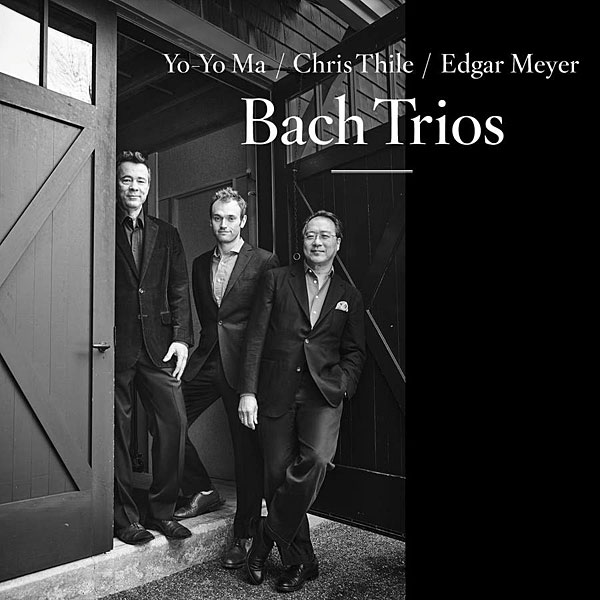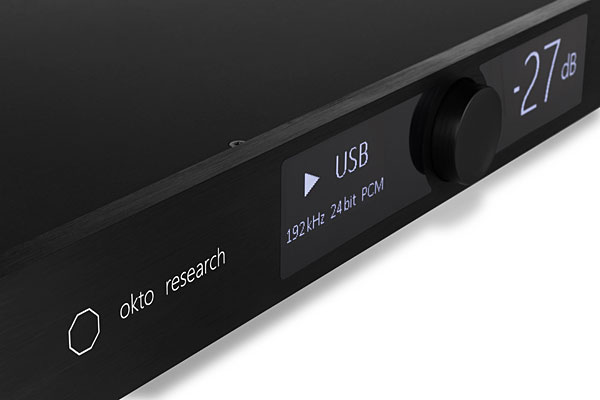| Columns Retired Columns & Blogs |
John you got the same measurements I did when I measured it last year which is good.
I have said this is the best DAC I have heard.
Once we had prepared the new hi-rez two-channel masters, I experimented with various redithering and downsampling options for the CD master, my goal being to preserve as much as possible of the original quality. The new CD (Albany TROY1848) arrived while I had the dac8 Stereo in the system. I was intimately familiar with the CD's sound, so it made a good guinea pig for comparing the Okto's filters.

The difference between the FRMP filter and the FRLP filter was very subtle, but Rod Gilfry's baritone had a slight edge to its tone with the linear-phase (LP) filter, as did Rich Mollin's double bass. The BW and AFRLP filters sounded identical to the FRLP. The two slow-rolloff filters, SRLP and SRMP, had similar presentations. I slightly preferred the minimum-phase (MP) filter, but neither had quite the smoothness in the high frequencies as the fast-rolloff MP filter. With the slow filters, both the tenors on this recording, Daniel Montenegro and Daniel Favela, took on a very slight degree of strain when singing at the top of their registers.
I wasn't sure what to expect from the HFRMP (hybrid, fast rolloff, minimum-phase) filter. My experience of this filter in other ESS Sabre–based processors that offered it as an option, like the Pro-Ject Pre Box S2 Digital (footnote 1), had been positive. But I had been so impressed by the Okto's FRMP filter that I didn't see how HFRMP could be any better. Well, on Cooperstown, the soundstage was a tad more well-defined in both width and depth with the hybrid filter. That slight emphasis of the edges on Gilfry's voice with the linear-phase filters was absent with this filter, though if I had to swear to it on my autographed copy of the opera's score, I felt the images of the voices in the triumphant vocal quintet in the middle of Cooperstown's ninth inning were slightly more palpable and slightly better delineated in space with the HFRMP filter.
I continued my auditioning with CDs and PCM files using the HFRMP filter. Again I must emphasize how small the audible differences were between these filters, smaller, for example, than the difference between the original KEF LS50 and the LS50 Meta that I reviewed in the January 2020 issue.
Headphone listening
I used my Audeze LCD-Xes to audition the dac8 Stereo's performance as a headphone amplifier. These headphones have an almost purely resistive impedance close to 22 ohms, which was not a problem for the dac8 Stereo's measured source impedance of 8 ohms from its front-panel ¼" jack. (To check that that was the case, I repeated my auditioning with the high-impedance Sennheiser HD 650 headphones. Other than the fact that the dac8 Stereo had barely enough gain for the insensitive Sennheisers, my impressions were identical.) I used the HFRMP filter for my headphone listening.

I cued up one of my 2021 R2D4 recommendations, the album of Bach trio transcriptions played by Chris Thile on mandolin, Yo-Yo Ma on cello, and Edgar Meyer on double bass (24/96 AIFF files, Nonesuch/HDTracks). The instruments were clearly and cleanly presented in a somewhat intimate space. When Ma and Meyer were playing in similar registers, the sounds of their instruments didn't blur together. Switching to the same album on Tidal encoded as a 24/48 MQA FLAC file and unfolded by Roon to 24/96 opened a slightly more transparent window into the recorded acoustic. Ma's cello in "Kommst du nun, Jesu..." was a tad smoother-sounding with the AIFF version, however.
On my other R2D4 recommendation, André Previn conducting the Royal Philharmonic Orchestra performing Rachmaninoff's Symphony No.2 in E minor (16/44.1 FLAC, ripped from CD, Telarc 80113), the strings on the famous "Never Gonna Fall in Love Again" tune in the third movement sounded rich without a hint of treble grain. The pizzicato double bass line after the start of the Allegro Moderato in the first movement lit up the acoustic of London's Walthamstow Town Hall. The way the composer occasionally doubles the double basses with tubas was clearly presented without any smearing together of the similarly pitched tonalities. The images of the various solo instruments remained small compared with the size of the orchestral backdrop, as should be the case. I had been present at one of the sessions for this album, and with the dac8 Stereo and Audeze headphones, I was transported back in time.
Comparisons
Back to listening with loudspeakers, still with the Okto's HFRMP filter. The best-sounding (and measuring) D/A processors I have used in recent months were the Weiss DAC502 ($9850), which I reviewed in August 2020, the Level 3 HoloAudio May ($4998), which I wrote about in September 2020, and the MBL N31 ($15,400). The Weiss and HoloAudio DACs have long since been returned to the manufacturers, but the MBL CD player/DAC, which I originally reviewed in February 2018, was back in the house in Roon Ready form for my Follow-up review in the December 2020 issue.

With levels matched at 1kHz using the warble tone from my Editor's Choice CD (STPH016-2), I set up the MBL and Okto processors so that they drove the Parasound monoblocks directly. Instantaneous comparisons were tricky, because I had to unplug the balanced AudioQuest cables from one DAC, plug them into the other, then rush back to the listening chair. I cued up "Love and Affection" from Joan Armatrading's eponymous 1976 album (16/44.1 FLAC, A&M/Tidal) in Roon. The MBL, with its Fast Rolloff filter selected, and the Okto both retrieved a superb amount of low-level detail, such as the faint ghost of ambience behind Ms. Armatrading's voice at the start of the song, the reverb-drenched rimshots at the rear of the soundstage, and the touch of flanging on the sound of the bass guitar. But the N31 handled the slight amount of spitchiness on the voice a little more gracefully than the dac8 Stereo, and its overall presentation had slightly greater sense of ease.
I had the same impression with the Rachmaninoff symphony. The tonal balance and transparency of the two processors were virtually identical, but the MBL stepped out of the way of the music a little more effectively. This should perhaps be expected, given that the N31 costs more than 10 times the price of the Okto. Still, the sound of the dac8 Stereo was competitive.
Conclusion
Not only does the Okto dac8 Stereo offer superb sound quality and state-of-the-art measured performance; its price is a fraction of what you'd pay for competing products. The only strikes against it are that the lead time on orders is quite lengthy, 6–8 weeks when I wrote this, according to the Okto Research website, and that service and support must come from overseas. A winner, nonetheless!

John you got the same measurements I did when I measured it last year which is good.
I have said this is the best DAC I have heard.

How does Chord Qutest sound compared to Oktos dac?

Hello John
Thank you for the review. What I glean from it is that the unit majors on detail retrieval, leading edge definition and resolution. You also mention that another more expensive DAC gets out of the way of the music more effectively - what does that mean exactly?
Also, any dac8 owners reading this: how would you describe the sound? Anything to add?

I haven't heard Okto dac8. But, as far as the measurements published in Stereophile are concerned - I think it's in the top 10, even the top 5 possibly. Rest assured, I'm ordering this.

Okto is definitely one of the best measured DACs at a fractional cost compared to other high-end brands.

When John Atkinson and ASR both agree that something is an extreme bargain I notice. It took me a year to find one on the resale market as the Okto site rarely has one posted for sale and they go almost immediately, like Stones tickets. Happily paid full retail price even though it's used. It should arrive here in a week or so. This should definitely up the digital side of my system. Thanks John.

Unable to purchase one directly from the manufacturer due to supply issues I managed to find a Pi-less version in mint condition online. Arrived yesterday. Simply stunning using HQPlayer playing my ripped flac files. Thanks John for your enthusiastic review. Now if only the manufacturer could find a way to figure out his production issues.

Have been listening to the Okto for about 6 weeks now. It's addicting - all the clarity and detail without any edge, images beautifully with the system it's in (which has B&W 702s2 speakers that I was only mildly happy with before). What I'd planned as a couple hours of trying headphones with the DAC last weekend turned into a day into night listening marathon. They are able to put out a few for purchase every couple weeks now, get on the email notification list. It's worth it.